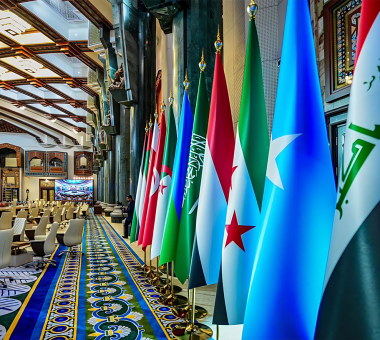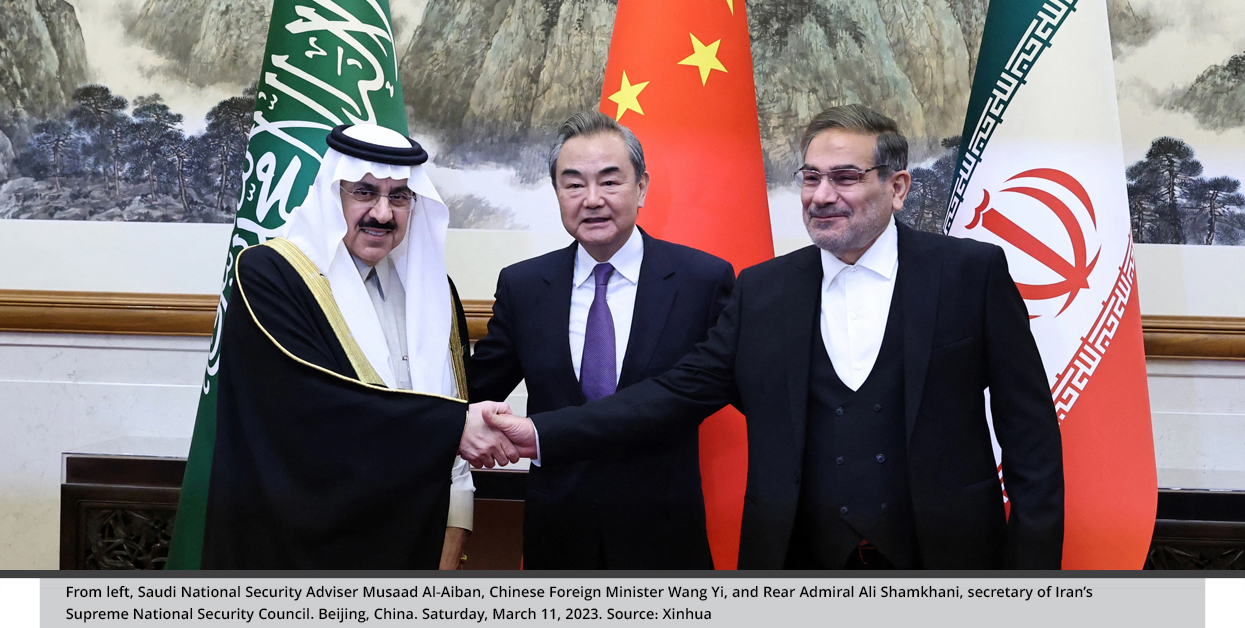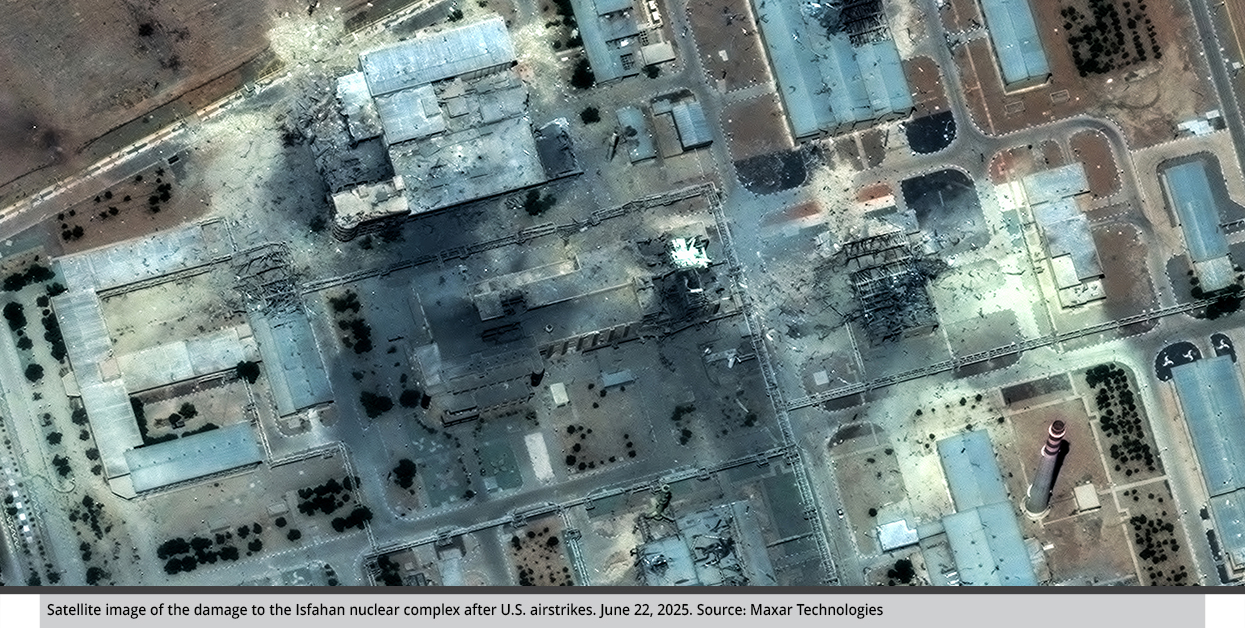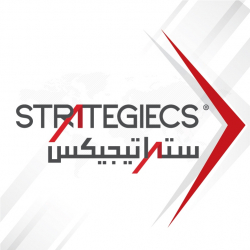The Arab Stance Amid Regional Variables
The war in the Gaza Strip and its repercussions on Lebanon and Syria, culminating in its spillover into the Iranian heartland in June 2025, marked a turning point in the balance of power that has prevailed since 2003. This shift resulted in the decline of the Iranian influence and the emergence of Israel as a central actor, and it rearranged the Arab alliances that began to fill the vacuum left by Tehran’s retreat. Worried about Israel turning into a dominant power, Arab states seek to re-engineer the regional balance to formulate a system based on cooperation rather than influence.
by STRATEGIECS Team
- Release Date – Jul 28, 2025

The war in Gaza—followed by subsequent developments in Lebanon and Syria, and eventually its spillover into Iran’s heartland on June 13, 2025—marked a strategic turning point in the regional structures that had shaped the balance of power since 2003. It also represented a decisive shift in the Arab approach toward key actors in the conflict, particularly Israel and Iran, amid a broader process of regional realignment and evolving threat perceptions and priorities.
Within this shifting landscape, Arab states—after years of limited agency in the face of major regional transformations, beginning with the U.S. intervention in Iraq and later the so-called “Arab Spring” that opened the door for Iran’s regional expansion at the expense of an Arab vacuum—now face a critical test of their ability to help shape the future of the Middle East.
In this context, Arab calculations regarding the future and their forthcoming regional choices will be pivotal in defining their positions toward Iran and its prospective role in the emerging regional order—as well as toward Israel’s rise as a central actor in post-war arrangements.
Post-2003: Arab Retreat and Iranian Advance
Arab-Iranian relations witnessed a transformation after 2003, specifically due to the role of the American military intervention in Iraq that led to a major shift in the regional balance of power. Iraq was sidelined as a key regional player, contributing to the rise of Iranian influence after it shifted from being a rival adversary to an ally. Meanwhile, Iraq descended into chaos with the rise of armed groups and non-state actors, whether extremist and terrorist organizations like al-Qaeda and ISIS, or Iran’s proxies from armed factions, who weakened Iraq’s ability to recover and reclaim its regional role until recently.
One of the most prominent consequences was that Arab borders came into direct contact with Iran and its proxies for the first time in history since the region’s independence from British mandate. This reshaped the geopolitical environment in an unprecedented way. And following the wave of unrest that swept the region in the wake of the 2011 Arab Spring, the contact line between Iran and both the Arab states and Israel expanded to an unprecedented degree following the wave of unrest that swept the region in the wake of the 2011 Arab Spring.
Iran viewed these upheavals as a historic opportunity to revive its regional influence project, capitalizing on the political and security vacuums that emerged across several Arab countries. This enabled Tehran to establish a strategic land corridor stretching from its eastern borders to the Mediterranean Sea, through its military and political entrenchment in Iraq, Syria, and Lebanon. It also expanded its presence in the Red Sea via Houthi-controlled territories in Yemen.
As a result, Iranian-aligned armed groups drew Tehran closer—both geographically and militarily—to much of the Arab world, as well as to Israel. These groups provided Iran with a wide array of tools for an operational reach deep into the Middle East.
Moreover, Tehran consolidated its encirclement of Israel through military and operational coordination with Palestinian factions in Gaza and the West Bank, adding a new layer of complex and overlapping threats with attacks and escalations carried out by Iranian proxies against Saudi Arabia, the United Arab Emirates (UAE), Jordan, Bahrain, and Israel.
Ultimately, the dynamics of regional balance began to tilt, though not decisively or overwhelmingly, in favor of Iran. This gradual shift triggered tangible changes in the pattern of regional alliances; states threatened by Iranian influence sought to forge new partnerships and alternatives to confront shared risks. This realignment led to a notable rapprochement between several Arab countries and Israel, which peaked during the first term of U.S. President Donald Trump (2017–2021).
That period witnessed the signing of the Abraham Accords in 2020 and the integration of Israel into the area of responsibility of U.S. Central Command (CENTCOM)—a move that reflected growing security and military coordination, both direct and indirect, between the United States, Israel, and a number of Arab states. This trajectory aligned with the Trump administration’s proposal for a regional alliance known as the “Middle East Strategic Alliance.”
Despite this momentum, however, U.S. policy fell short of curbing Iran’s nuclear and missile programs or limiting Tehran’s support for proxies that destabilize the region. In fact, Washington’s increasing pressure—particularly following its 2018 withdrawal from the nuclear deal and the adoption of a “maximum pressure” strategy—arguably pushed Iran toward greater hardline behavior. This was evident in the rise of conservatives within Iran and in the nature of its regional conduct in general.
Post-2021: Containing Disputes and Accepting Iran’s Role
Arab-Iranian relations underwent a notable shift after 2021 driven by two key developments. The first was former U.S. President Joe Biden administration’s preference for a diplomatic approach with Iran, in line with the Obama-era strategy. This included efforts to revive the nuclear deal in a modified form from the 2015 agreement, alongside a gradual easing of sanctions.
The second driver was a growing regional consensus on the need to reach understandings that could end the exhausting cycle of instability that had strained state resources and economies. This was particularly true for several Arab states—chief among them the Gulf countries—that had launched wide-ranging economic reform programs that made regional stability a top priority in both their domestic and foreign policy agendas.
These developments led to a shift in the dynamics of interregional relations and in the nature of prevailing regional discourse—from one focused on rivalry and conflicting positions over ongoing conflicts to one centered on shared opportunities and common ground that could reshape the region’s fragile security landscape.
This transition marked the beginning of a broader process of dispute resolution that started in 2021 when the 41st Gulf Cooperation Council summit in Al-Ula, Saudi Arabia, restored the relations between Saudi Arabia, the UAE, Bahrain, and Egypt with Qatar, bringing an end to a rift that had persisted since 2017.
The next year, Turkey’s reassessment of its foreign policy and a renewed openness toward mending ties with Arab states was reflected in President Recep Tayyip Erdoğan’s 2022 visits to the UAE in February and Saudi Arabia in April, along with exploratory talks to restore relations with Egypt beginning in 2021.
These developments culminated in the resumption of Saudi relations with Iran on March 10, 2023, after being severed since 2018, alongside increasing talk within the United States about an imminent Saudi-Israeli agreement. Indeed, the entire regional system may enter a new phase and witness advanced patterns of integrative economic, and investment relations.

Nevertheless, Iran’s positioning within the series of reconciliations was seen as a strategic outcome of its negative regional behavior, and it even reinforced its regional influence. In order to maintain its strategic position in Syria, Tehran’s influence remained present through the control of its proxies over the political and security scenes in Iraq and Lebanon. Iran also closely monitored the course of Arab rapprochement with the former Syrian regime within the framework of a “step-for-step” policy that culminated in Damascus regaining its seat in the Arab League in May 2023.
Regarding the Yemeni file, Tehran benefited from the international momentum supporting the settlement path reflected in the UN-sponsored peace talks, in addition to the Biden administration’s decision to remove the Houthis from the list of terrorist organizations in February 2021—before they were renamed a terrorist organization in January 2024 and then reclassified again as a foreign terrorist group in January 2025 under Trump’s administration. Even Israel implicitly acknowledged Iran’s regional superiority and its influence over wide areas of its borders. Its launch of “Operation Heimlich,” using intelligence tools first and then military power, played a role in preventing Iran from reaching a point beyond the control of Israel and other countries in the region.
Accordingly, the transformations that have occurred in Arab-Iranian relations after 2021 can be understood as part of a broader regional dynamic—aimed at reengineering security balances through tools of de-escalation and political openness—that ensures all actors remain within the bounds of an acceptable role without full-scale escalation.
This aligns with the concept presented in the STRATEGIECS Think Tank white paper, “Using the Heimlich Maneuver to Shift the Regional Security Landscape,” which emphasizes that regional de-escalation does not mean dismantling power tools but rather restructuring them within a flexible regional system—without reaching the point of explosion and full-scale succinct escalation.
October 7: The Erosion of Deterrence and the Decline of Iranian Influence
The attacks launched by Hamas and other Palestinian factions in the Gaza Strip on Israeli settlements and military bases in the Gaza envelope marked a pivotal event that returned the region to a state of multi-front conflicts—in Palestine, Lebanon, Yemen, Iraq, and Iran—under what became known as the “Unification of Arenas” strategy against Israel. At the time, the scale of the war and the breadth of its engagement had a clear impact on the future of the region and its strategic choices: either the consolidation of Iranian influence in an exceptional and unprecedented manner or limiting that influence and the emergence of alternative centers of influence.
During this period, both Arab and Iranian positions opposed the war in Gaza and called for its cessation. Iran even participated in the Extraordinary Arab-Islamic Summit held in Riyadh in November 2023. However, once again, divergences emerged in how both sides approached the means and tools of response to the conflict.
While Arab states prioritized political solutions, diplomacy, and a strategy of coordinated pressure to bring the war to an end, Iran pursued a policy of escalating military attacks against U.S. and Israeli targets. Tehran and its proxies demonstrated a significant level of military escalation, showing little hesitation in dragging the region back into a state of conflict. This posture posed serious risks to the Arab states’ national, joint, and transregional economic projects.
However, beginning in September 2024, signs of collapse began to emerge within the Iranian-led axis and its regional proxies. Iran’s deterrence capabilities started to erode following a series of decisive Israeli strikes against one of its most important allies, Hezbollah in Lebanon, that dismantled its leadership structure and destroyed a large portion of its missile arsenal.
This was followed by a dramatic shift in Syria, where the pro-Iranian regime was replaced in December 2024 by forces opposed to Tehran. Meanwhile, Palestinian factions in Gaza saw their capabilities significantly weakened, and the activities of armed groups in the West Bank were largely neutralized, especially after Israel launched “Operation Iron Wall” on January 21, 2025.
Arab states moved swiftly to fill the strategic void left by Iran’s retreat. They engaged with the emerging political authority in Syria and supported the shift in Lebanon’s political landscape away from Hezbollah’s previous dominance. Arab and Gulf delegations were among the first to visit Damascus and Beirut, an early recognition that signaled their commitment to reintegration.
Multilateral Arab efforts also played a key role in closing potential gaps that Iran might exploit to regain its foothold in either country. In a short span of time, both Syria and Lebanon transitioned from isolation to active reintegration into Arab and international political and economic spheres.
Lebanon, in particular, began taking initial steps toward dismantling what remained of Hezbollah’s arsenal—a force that, for years, had been one of the central pillars of Iranian influence and power in the region.
The 13-Day War: A Prelude to Shifting Regional Power Dynamics
The Arab states remained distant from participating in the broader escalation between Iran and Israel—whether direct or indirect—focusing instead on ending the war in the Gaza Strip, while maintaining a degree of pragmatism to preserve the balance in their relations with both countries.
However, the events following the January Israeli military campaign and its undermining of the actors involved in the “Unification of Arenas” strategy significantly complicated Arab calculations, especially after Israel began targeting Iranian military capabilities on June 13, 2025, soon followed by the precise U.S. military strike on June 22 against three central nuclear facilities: Fordow, Natanz, and Isfahan.
The positions of Arab and Islamic countries—21 of which have already condemned the Iranian attacks—were based on three main pillars.
Iran’s Collapse Into Chaos Would Harm Its Neighbors and the Region
Targeting the capabilities of the Iranian regime may undermine its control over the country’s geography and could, over time, lead to its collapse. Moreover, Iran’s comprehensive internal instability could have cross-border security and economic repercussions affecting various Middle Eastern countries and exacerbating the region’s already fragile situation.
While it is true that Arab-Iranian relations have remained cautious since 1979, and that the fall of that regime may serve Arab interests by opening the door to pragmatic and cooperative relations with Iran, it is equally important not to overlook the risks of a sudden or uncontrolled collapse of the regime, especially in the absence of clear political alternatives or institutional structures capable of containing the chaos.
An Imbalance of Power Could Push Israel to Establish Itself as the Dominant Force
Many Arab countries have increasing expressed this concern based on Israel’s demonstrated advanced military capabilities, which have enabled it to carry out precise and effective strikes against Iranian and Houthi targets more than 2,000 kilometers away from Israel’s borders. This continuous display of air, military, and intelligence power reinforces the concern that Israel may seek to fill the vacuum left by the decline or collapse of Iran’s role, potentially repeating the regional scenario that allowed Iran to expand after 2003 and again after the 2011 instabilities.
Since the the War in Gaza, Arab States Have a Clear Desire to Avoid Escalation
This approach intensified following the Israel’s strikes on Iran, with increasing concerns over the potential expansion of the conflict into Arab countries and key trade routes in the region, especially the Strait of Hormuz. Given the close connection between the security of these routes and the stability of Arab economies, any wide-scale military escalation could lead to significant disruptions in energy supplies and trade flows threatening regional economic stability.

The Arab Choice in Facing Regional Change
Arab states have drawn lessons from their past experiences amid broad geopolitical shocks and aftershocks in the region—particularly their withdrawal from the Iraqi scene after 2003 and their disengagement from Syria after 2011, both of which granted Iran greater freedom to maneuver and expand its influence.
Arab countries view the recent upheaval as an especially important opportunity to establish a form of regional balance without allowing any single country to dominate. This represents a strategic Arab opportunity to effectively contribute to the reengineering of the regional order, with all that entails in terms of shifting alliances and frameworks of relations. Meanwhile, the race to shape the geopolitical landscape in the region has already begun, notably between Israel and Turkey, starting from the Syrian arena. Given this reality, Arab options are largely conditioned by developments in both Iran and Israel.
Options Regarding Iran
On Iran’s side, as fears regarding its influence have waned following the weakening of its tools and its shift toward domestic priorities, Tehran is now compelled to undertake a profound reassessment of its foreign policies toward Arab states. This is essential for maintaining regional acceptance and avoiding isolation—especially after losing much of the unilateral leverage that once allowed it to impose its agendas during periods of isolation.
However, this fundamentally depends on the developments within Iran’s domestic landscape. The rise of reformist and moderate forces in Iran could facilitate establishing pragmatic relations with both Arab and Western countries, while curbing the influence of the Iranian Revolutionary Guard Corps in shaping Tehran’s regional foreign policies.
Conversely, if the regime moves toward greater hardline measures out of fear for its security and stability, this will negatively affect Arab and Western approaches toward Iran, limiting any steps that would allow Tehran to participate effectively in the emerging regional order. This is especially relevant given that critical issues—Iran’s missile program, nuclear assets, relations with non-state actors, and broader regional behavior—remain on the negotiation table with the United States with no significant change in the Arab stance toward Iran since before the war and its aftermath.
On the other hand, Arab states maintain their economic priorities and vision of a regional order based on cooperation, integration, and partnership—rejecting any single dominant power. Consequently, just as Arab states set conditions for Iran, similar requirements are expected of Israel if it seeks genuine integration into the regional system.
While Arab countries closely monitor Israel’s behavior and policies toward Gaza and its excessive expansion in the West Bank, these issues directly intersect with critical files that could complicate relations. Among the most significant is the expansion of normalization agreements to include Saudi Arabia and, by extension, Syria and Lebanon. Riyadh has made the establishment of a Palestinian state a fundamental condition for normalization.
Given the ongoing war in Gaza and the unprecedented humanitarian crisis accompanying it, it will not be easy for Israel or the United States to advance a new package of agreements. Thus, the Gulf states Trump visited this May were able to establish a parallel track alongside the Israeli and U.S. military campaigns. They leveraged this path to advance economic projects and achieve a fundamental shift in U.S. policy toward Syria—particularly following Trump’s decision to lift sanctions on Damascus in late June.
Options Regarding Israel
Mirroring the options facing Iran, Israel now faces a choice: genuine integration and expanding normalization agreements in exchange for granting Palestinians their rights, halting the war, and ending military showdowns versus confronting regional isolation and exclusion stemming from upcoming regional arrangements for which Israel itself contributed in laying the groundwork.
The Syrian case (where combined pressures led to a shift in U.S. policy from non-engagement to near-full involvement) serves as a clear example. In this context, the events in Suwayda are a telling example of Israel’s evolving approach in Syria and its connection to the Arab stance on reshaping regional balances. Israel’s direct military intervention in the governate in mid-July 2025—through airstrikes targeting forces of the transitional government’s army and security units, as well as military sites in Damascus, Daraa, and Latakia—reflects a shift toward a policy of proactive intervention deep within Syrian territory.
This shift is understood—and condemned—in Arab political circles as an Israeli attempt to redraw the boundaries of influence in southern Syria and to impose a new security reality on the ground, in violation of Syrian sovereignty. The Arab states, seeking to limit the roles of non-Arab regional powers, are approaching Israel’s actions in Suwayda with double caution. They recognize the importance of curbing Iranian influence in Syria and preventing its return, but without allowing Israel to legitimize its interventions through minority groups, thereby repeating the Israeli model in Lebanon during the 1970s and 1980s.
Accordingly, the Syrian file—specifically the situation in Suwayda—serves as a microcosm of the Israeli-Arab approach in the post-Gaza war era. If Israel seeks to expand normalization agreements to include Saudi Arabia, Syria, and Lebanon, Tel Aviv will need to engage within an Arab environment based on cooperation and balance by restraining its regional behavior—not only in Gaza and the West Bank, but also in how it addresses Syria’s internal crises—of attempting to achieve unilateral dominance.
This is especially relevant in light of clear Arab conditions tied to the normalization equation. Otherwise, any attempt to impose unilateral facts on the ground will be met with Arab resistance, leading to Israel’s exclusion from the new regional arrangements—even if it remains a strong military actor—just as happened with Iran, which exploited chaos to expand its influence at the expense of Arab consensus and state sovereignty.
In conclusion, the regional system today faces a critical crossroads that could lead to comprehensive regional integration—including Iran or Israel, or both—within political, security, and economic arrangements that reshape the balance of power in the Middle East. However, based on the lessons learned from the post-2003 and post-2011 periods, the possibility of renewed competition and conflict over influence remains.
In this context, the Arab approach toward both Iran and Israel is determined by their behavior and regional positioning, as well as the trajectory of regional balances in the post-war phase. This makes the ability of Arab actors to manage their strategic interests and steer the region’s dynamics a decisive factor in the future of regional stability.

STRATEGIECS Team
Policy Analysis Team
 العربية
العربية